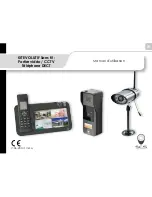
24
SOLO6 - TWIN6 - SUB12
Professional Analogue Monitoring System - User Manual
"HF" SHELVING
This control adjusts the level of high frequencies above 4.5kHz to ± 3dB (
fig. G
).
"LMF" EQ
The LMF EQ knob activates or deactivates a volume correction at a central frequency of 160Hz for a Q factor of 1. We
recommend that you set the switch to -1, -2, -3dB if the loudspeakers are positioned on a table, console strip or any other
support generating reflections (
fig. H
).
"LF" SHELVING
This control adjusts the level of low frequencies below 150Hz to ± 3dB (
fig. G
). This setting will be very useful depending
on the positioning of the loudspeakers on a console, near a wall or in a corner, where we tend to reduce these frequencies
to varying degrees.
Light
There is an On/Off “LED” indicator on the front panel of the loudspeaker, above the Focus mode indicator, near to the
“Focal” logo.
Focus mode
FOCUS mode is used to switch from 2-way (and 2.5-way for Twin6) to 1-way mode.
Solo6 and Twin6 (in FOCUS mode) offer a frequency response of 110Hz to 10kHz, making it possible to check the transfer
quality of mixes on systems with a limited bass frequency response like televisions, computers, cars, iPod® docking stations
or any other multimedia system.
Focus mode also makes it possible to check the midrange and mid-bass registers, which are always very critical to equalise
and balance in terms of volume compared to the other information contained in the audio signal. It provides a listening
experience that is as close as possible to the sound signature of 2-way mode (and 2.5-way for Twin6). This way of listening
to a full-range speaker driver also permits another approach to the stereo image whilst retaining the same sweetspot.
INPUT
Input for connecting the footswitch-type control pedal to a switch, or for receiving the signal transmitted by the OUTPUT
of the FOCUS mode of a Solo6, Twin6 or Sub12 loudspeaker.
OUTPUT
Output for connecting the Solo6 or Twin6 loudspeaker to a second Solo6, Twin6 or Sub12 loudspeaker.
Ensure that you use an instrument cable equipped with 2x 1/4" (6.35mm) jack connectors (or Stereo, depending on the
pedal) to connect the control pedal to a Solo6 or Twin6, as well as to connect two loudspeakers together.
Controls specific to the Sub12 (fig. F)
Level
The Sub12 level adjustment is used to set the subwoofer’s volume according to that of the monitors. This setting also offers
the option to optimise the choice of the subwoofer's positioning, taking into account the acoustic consequences inherent
in positioning the Sub12 (in a corner: +6dB, therefore necessity to attenuate the level to achieve perfect linearity of the
frequency response curve for the whole system).
High pass
This zone is dedicated to controlling the “high-pass” crossover of the loudspeakers linked with the Sub12 when in 2.1
configuration. The 45Hz/60Hz/90Hz switch is used to select a cut-off frequency, so as to optimise the coupling of the latter
with the Sub12 subwoofer.
Low pass
This rotary potentiometer is used to adjust the subwoofer's low-pass cut-off frequency in order to determine the highest
frequency that the Sub12 will have to re-transcribe. The aim of this setting is to optimise the Sub12’s cut-off frequency.
The aim is of course to obtain the most linear frequency response curve possible from the whole system (sub
loudspeakers). The low-pass crossover is no longer active as an LFE channel.
















































